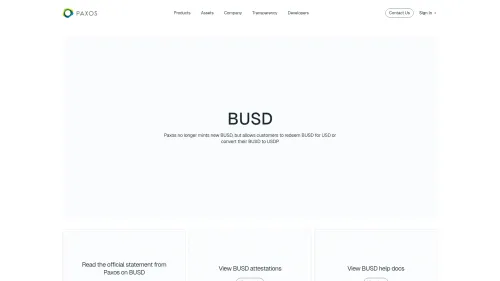BUSD (BUSD)
Binance USD (BUSD) is a stablecoin pegged 1:1 to the US dollar. It is issued through a collaboration between Binance and Paxos and regulated by the New York State Department of Financial Services (NYDFS). BUSD allows users to engage in transactions with various digital and blockchain-based assets while aiming to reduce volatility risks. There are three types of BUSD tokens: ERC-20 tokens issued by Paxos, Binance-pegged tokens on BNB Chain, Polygon, and Avalanche, and wrapped tokens on different blockchains. BUSD is fully backed by reserves held in insured US banks, cash, or US Treasury bills, ensuring its stability.
A key feature of BUSD is its deflationary model that maintains each token's 1:1 parity with the US dollar. When BUSD is bought, an equivalent amount is minted, and a corresponding payment is added to Paxos reserves. Conversely, when BUSD is sold or redeemed, the corresponding amount is deducted, and the tokens are burned. BUSD supports ERC-20 smart contracts and BEP-2, facilitating secure transactions and interoperability across Ethereum-supported platforms.

| Ticker | BUSD |
| Category | Stablecoins |
| Website | https://www.paxos.com/busd/ |
| @PaxosGlobal | |
| Contract Addresses | |
|---|---|
| ethereum | 0x4f...53 Copied! Copied! |
History
BUSD was launched on September 5, 2019, through a partnership between Binance and Paxos, receiving approval from NYDFS. It became available for purchase on September 12, 2019, and was later listed for trading on Binance against Ripple (XRP), Bitcoin (BTC), and Binance Coin (BNB) on September 20, 2019. The stablecoin was well-received, leading to its expansion to 48 USD pairs. BUSD undergoes monthly audits by Withum, ensuring compliance with NYDFS regulations.
In April 2022, Binance donated $2.5 million in BUSD to the USA for UNHCR through its charity organization. In February 2023, Paxos was directed by NYDFS to stop issuing BUSD, and Binance began minting TrueUSD (TUSD) as part of its strategy to diversify stablecoin reserves. Binance later replaced BUSD in its Secure Asset Fund for Users with TUSD and Tether (USDT). As support for BUSD phases out, Binance encourages users to convert their holdings to other assets, including First Digital USD (FDUSD), a stablecoin launched in June 2023.
Utility
Staking and earning system
BUSD offers a staking and earning system within the Binance ecosystem. It is used for payments on platforms like Alternative Airlines and Ledger Shop and serves as collateral for loans. In collaboration with BitPay, BUSD is accepted by merchants such as Microsoft and Amazon.
Maker fees
Binance provides zero maker fees for users trading through BUSD spot or margin trading pairs. All BUSD stablecoin pairs on Binance have zero transaction fees.
Trading options
BUSD offers diverse trading options, enabling swaps or purchases of various cryptocurrencies. It supports 48 trading pairs, including those against the Chinese yuan and Russian ruble. BUSD can also be used to purchase NFTs on the Binance NFT Marketplace.
Margin trading
BUSD can be used in Binance Margin Trading, serving as collateral for loans. Users can deposit BUSD in various lending products to earn up to 15% in annual interest.
Stablecoin conversion
Binance allows users to convert other stablecoins to BUSD at a 1:1 ratio without fees. This feature supports stablecoins like TUSD and USDC.
Minting and burning
Binance employs a minting and burning mechanism to maintain the 1:1 reserve of BUSD to the dollar. When users deposit fiat dollars into the Paxos reserve, new BUSD tokens are minted and sent to their wallets. BUSD operates as a deflationary token, with redeemed tokens being burned to ensure the token supply matches the dollar value.
Tokenomics
BUSD's supply is not fixed, as Paxos manages the allocation, maintaining USD reserves that underpin each token. Regular audits by third-party accounting firms verify that these reserves match the total circulation of BUSD tokens. This ensures that every BUSD token is backed by US dollars and can be exchanged for USD at any time.
Regulations
BUSD is subject to specific operational requirements set by New York state regulators. These include full collateralization, authority over token creation and burning, and the ability to freeze accounts if necessary. These measures align with the Trust Charter and New York banking laws applicable to stablecoins.
